Hello, and happy Earth Day!
During my thru-hike of the Appalachian Trail, I witnessed an emergence of the periodical cicada while camped in the woods of North Carolina. Here is my story, and then, what you need to know about the imminent emergence of periodical cicadas.
For me, there is such peace in the quiet moments of night and in the absence of artificial light. Not wanting to spoil the mood, I moved away from my small campfire at my campsite, standing in the darkness. Suddenly, I became aware that it wasn’t quiet. But what was it I was hearing? It wasn’t wind or rain. I remained motionless, listening to the soft sounds of what sounded like thousands of tiny animals moving through the carpet of leaves. Curious, I flicked on my headlamp, squatting to direct the beam onto the ground.
What I saw made me gasp in delight, because I knew that these were periodical cicada nymphs that had spent the last 13 or 17 years underground, sucking on the sap from tree roots. So many challenges they had overcome in that time! And now! Under the veil of darkness, they were ready to transform into winged adults. And I just happened to be there to witness it! I felt like I’d just won the lottery.
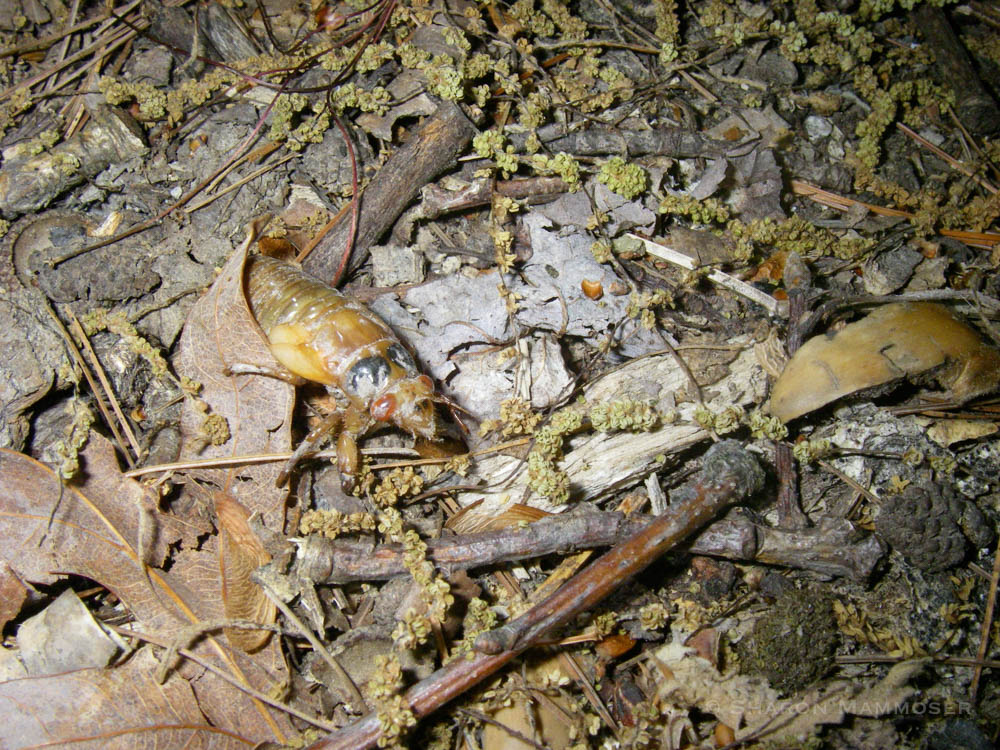
Emerging from perfectly round holes the size of a penny were inch-long creatures with pale bodies. In every direction I saw them, an army of cicadas, all with the same goal: a safe place for their transformation. Slowly, but with persistence, the fat pasty creatures shuffled along the ground, crunching through the leaves and moving around obstacles. When they arrived at a bush, shrub, tree trunk, stick or even my leg and bear bag rope, their journey turned upward. They climbed, gripping the rough surface with their clawed feet. Up and up they crawled, making tiny noises as their feet moved them higher. When satisfied, they stopped and became perfectly still.
I watched as one rested motionless on a giant tree trunk in front of me. After a short time a line along the top of the creature’s back opened. And then! A tiny beast within the hard shell broke free and began to slide out, silently, emerging like something in a science fiction movie.
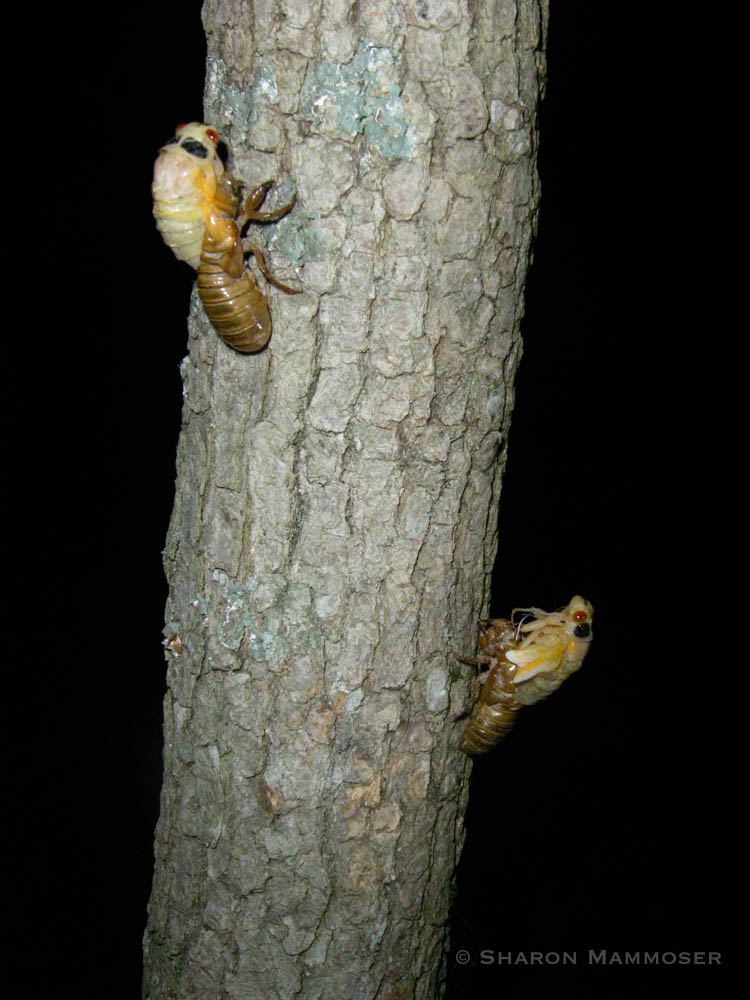

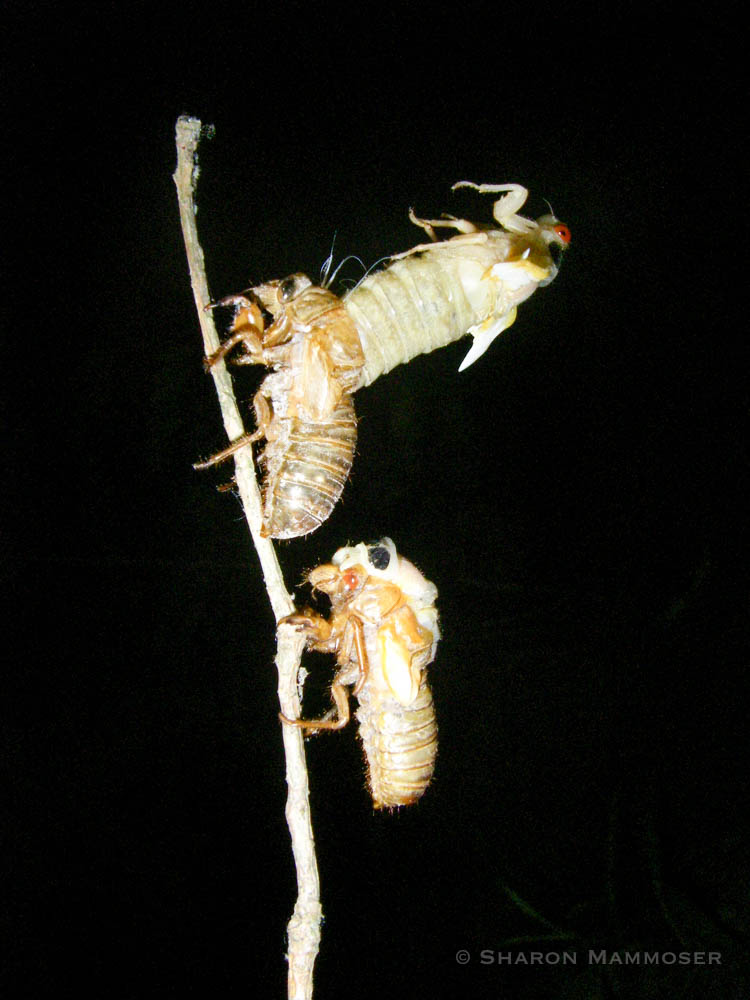
I watched, awed. Out and out and out came the new creature until it seemed certain it would pop clear out of the old skin and fall to its death on the forest floor. With its back and crinkled wings aimed at the ground and its beady eyes facing the heavens above, its inch-long body was almost exactly perpendicular to the ground and it seemed at an impossible angle to save itself. But then, when I had no faith at all, it bent its pale body, reached forward with its legs to grab the discarded skin of its former life.
I felt like cheering when it successfully completed the maneuver, freeing itself completely from its nymphal skin, moving to position its pale body against the tree. And again, it rested, still and silent. With beady red eyes, two short antennae, a black spot on its back behind each eye, and thick, grub-like body, its orange-veined transparent wings stretching out as I watched. All around me, on every tree trunk, this was happening. The forest was alive with the activity of these periodical cicadas, with only me to witness it.
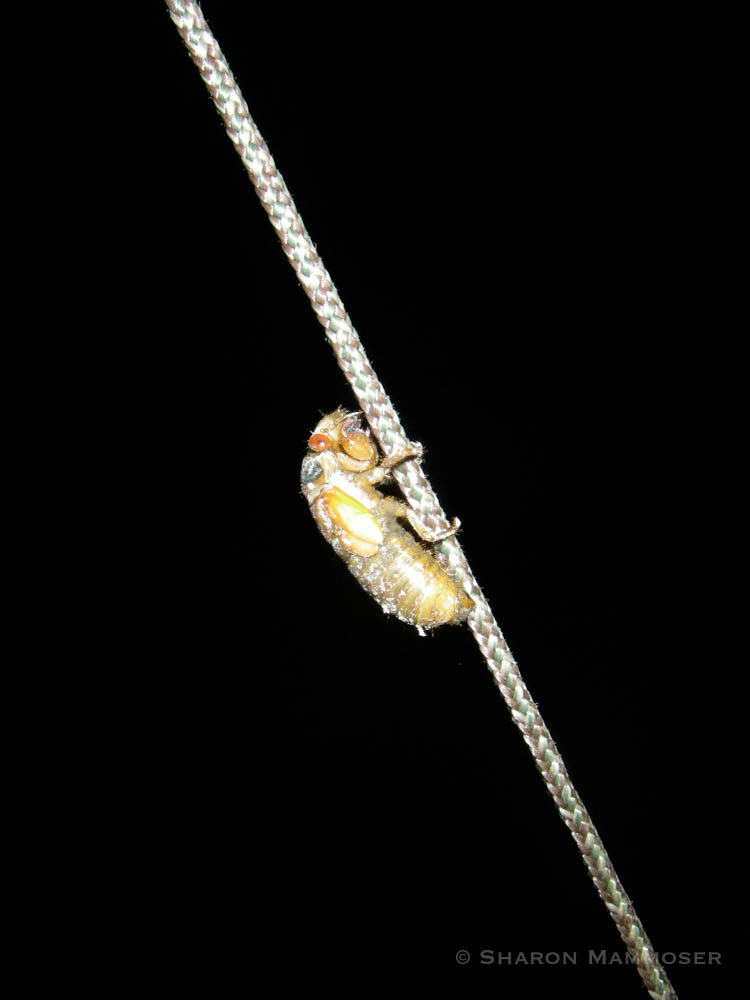
Eventually, the weariness of hiking all day set in and I retired to my tent, leaving the emerging cicadas secreted in darkness again. As I closed my eyes and prepared for the sweet relief of sleep, I felt grateful for the music of wild things, knowing that tomorrow would bring a new kind of music as all of those cicadas would sing from the treetops. The calls of some cicadas can reach 120 decibels and can be heard up to one mile away!
Unless you never read a newspaper or see a TV, you’ve probably heard about the coming of the cicadas this spring. In a rare event, both the 13 year and 17 year cicadas will be emerging on a day soon when the temperature at 8 inches underground reaches 64.5 degrees. In some locations in the eastern US, there may be as many as one million per acre.
But most who tell the story of the periodical cicada frame it far differently than I, a lover of all things wild. Attention-grabbing headlines use words like invasion, onslaught and even assault, often wrongly referring to these amazing insects as locusts. You probably won’t see words like phenomenal, extraordinary, miraculous or wondrous. But I want you to consider how sad that is.
This emergence of the periodical cicadas should be an awe inspiring event, worthy of the same praise and anticipation as a meteor shower, or dare I say, solar eclipse. Did you know that periodical cicadas are found ONLY in North America, or that there is not just one, but 7 species of periodical cicada? How special that should make us feel! Shouldn’t we be celebrating them then, instead of talking about them as if they are a plague?
Cicadas do not bite or sting. They do not carry disease. Instead, they provide food to many, many animals. They aerate the soil and improve water filtration. In addition, their mass emergence turns over large amounts of soil and their decaying bodies return valuable nitrogen and nutrients to the soil.
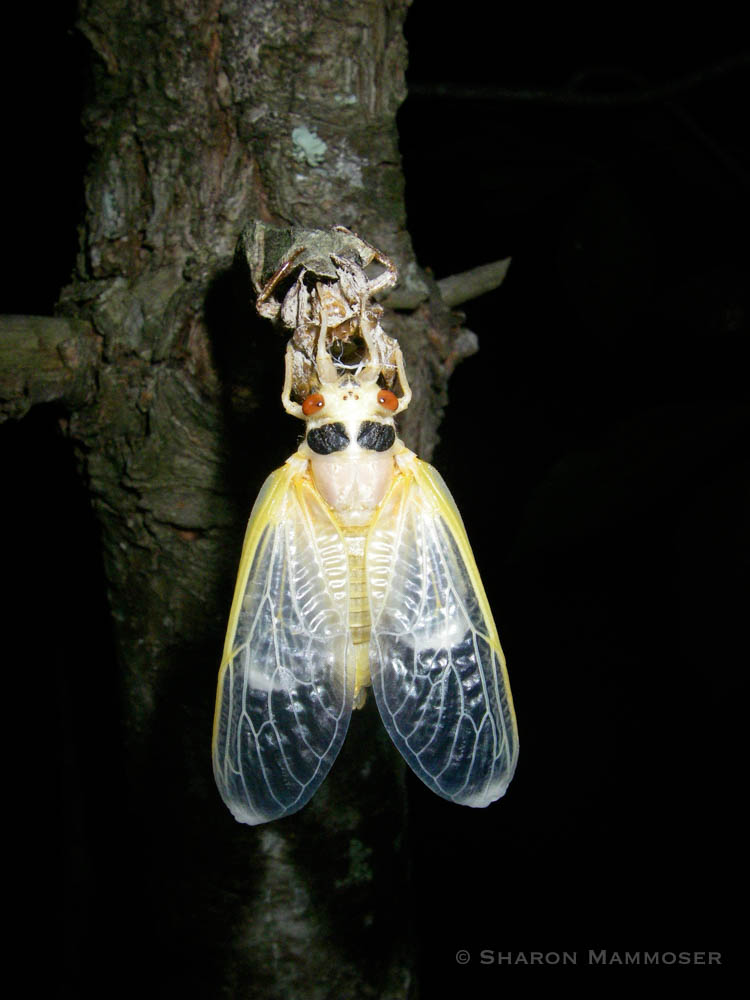
These small, inch-long insects have lived and thrived underground, for 17 years! That fact is astonishing, especially when you consider that most insects live less than a few weeks, some, only a few days as an adult. Cicadas have gone through 5 molts in their underground burrows, steadily growing and feeding. These nymphs do no damage to the trees from which they feed. Consider the predators, the droughts, floods, constructions projects and other obstacles they’ve managed to avoid. It is miraculous that such a small animal–an insect! has survived this long.
I was horrified and deeply saddened recently when I did some general research and found articles telling people things like, “cicadas can pose a risk for animals and some plants and trees. They’re not harmful to humans, but their large numbers and constant noise can be burdensome. If you’re wondering how to get rid of cicadas, you’ll need to take action to keep them in check… Cicada grubs will eat plant roots and females may lay their eggs on plant leaves, so you may want to protect all of your plants with an insecticide.”
Protect your plants with an insecticide?! Nothing could be further from the truth. Please!
Why are we so intent on raising a generation of people who hate insects, when our world COULD NOT exist without them? Like birds? Well guess what? 95% of our beloved songbirds require caterpillars and other insects to feed their growing chicks.
Pest control companies are out to make money, not be good stewards of our Earth. Controlling these cicadas with pesticides or insecticides is unnecessary and will kill many animals and plants besides their intended target. Adult cicadas DO feed on plant fluids but they aren’t going to eat your leaves, fruit or garden veggies. They’re not going to kill your flowers or hurt your children or pets.
Adults are intent on finding a mate, and then, if female, laying eggs. Females will insert their ovipositor into small branches to lay up to 20 tiny eggs in a spot. Mature trees may experience some natural pruning from the egg-laying, but it’s not usually going to damage the tree. The only time you have to worry is if you have young (under 4 years) trees, such as in an orchard, because the branches of these trees are about the perfect diameter that females seek for laying eggs. In this case, to protect saplings, you can cover the tree with a fine mesh netting and leave on for the duration of the adult lifespan, which is only a few weeks.
The eggs will hatch out into tiny nymphs in about 6-10 weeks, long after all of the adults have died. They will fall from the trees, burrow down into the soil, find a rootlet and begin feeding. And the cycle will continue.
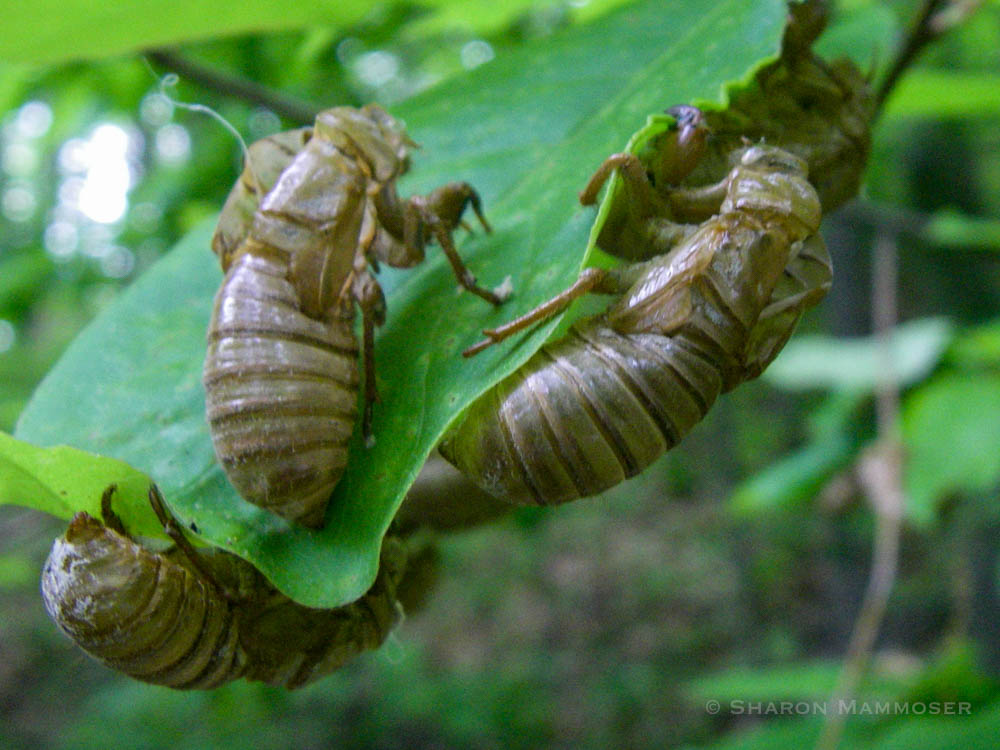

Let’s change the way we talk about, and view these, and other insects. We should be celebrating the emergence of this incredible insect and embracing the opportunity to witness the spectacle, rather than applying poisons in our yards or engaging in fear mongering.
It’s going to be amazing! I hope you’ll join me in embracing this true miracle– courtesy of Mother Nature.


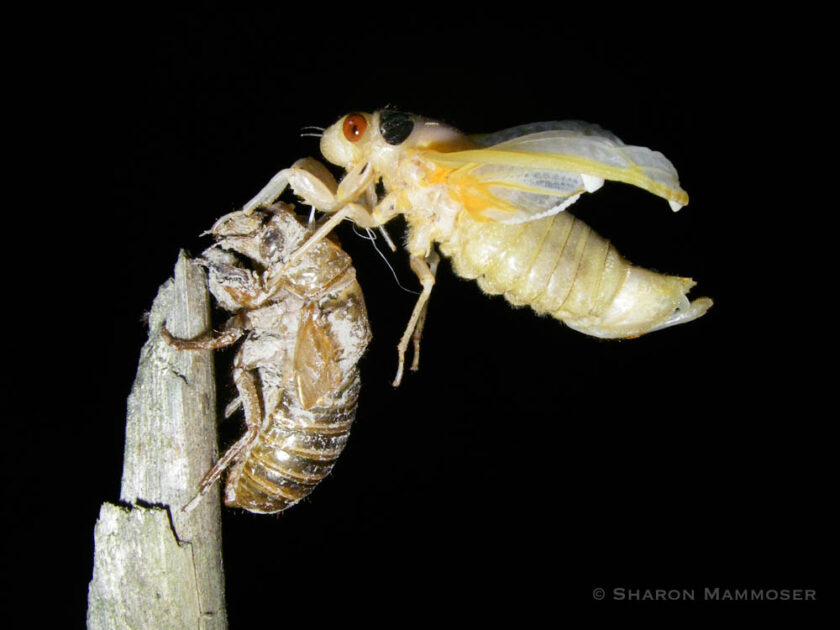
Wow, Sharon. The photo shots you took of the transformation of nymph to adult cicadas are fantastic. Thank you for sharing them.
You’re welcome Renee. Thanks for taking time to let me know!
Fascinating! Thank you for giving a different perspective that encourages curiosity instead of fear. Loved reading about your experience and seeing the photos. Miraculous! Wish a major publication would print your story.
Thank you, Leslie. I appreciate the feedback.
Sharon, I am an UpState South Carolina Master Naturalist and I am looking forward to an Advanced Class in May that will teach me more about Cicadas. It is taught at Landsford Canal in Catawba, SC and named “Cicadas and Spider Lilies” for the Rocky Shoals Spider Lilies that grow in the shoals of the canal.
I will see you on the 11th for Blue Ghosts!
Thank you for further info on Cicadas! I find them awesome! Do you know the children’s book “When the Woods Hum” by Joanne Ryder? Beautiful!
Hey Pam, I do not know that book, but will definitely look it up. Thanks for the recommendation. The cicada class sounds great! I’m sure it will be interesting…. yes, see you in May!!